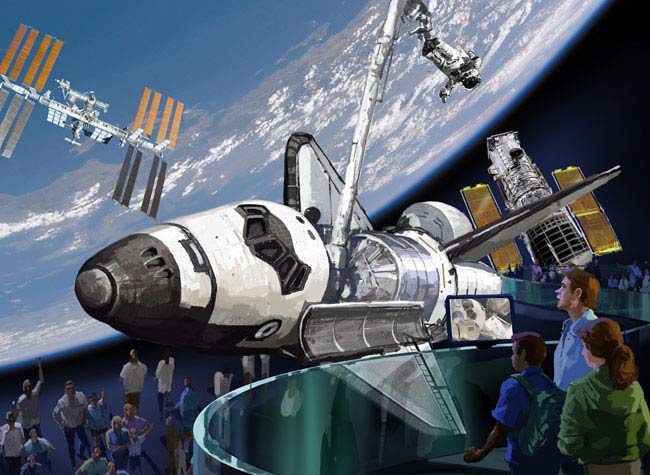Congress, Spaceport Propose Display Plans for Retired Space Shuttles

Plansare moving forward for the display of two of NASA's soon-to-be-retiredspaceshuttles at the Smithsonian and Florida's Kennedy Space Center.
AlthoughNASA has yet to announce where its orbiterswill be dispatchedonce they ceaseflying missions next year, recent actions have helped remove obstaclesandclarify the logistics for the Washington, D.C. institution and the CapeCanaveral, Fla. spaceport to receive shuttles.
Inthe case of the Smithsonian, it was long thought to be the future homeofshuttle Discovery, NASA's oldest flying orbiter. Recently, budgetconstraintscalled that plan into question.
Asfirstreported by collectSPACElast month,NASA was not prepared to cover the estimated $28.8 million needed toprepareand transport the shuttle to the institution.
NowCongress is passing legislation to make NASA do just that.
TheKennedy Space Center Visitor Complex wouldn't incur the costs to fly ashuttleto its facility ? it would simply need to roll the orbiter down theroad. Butup until now, the tourist attraction has trailed many of the other 20shuttlesuitors releasingtheir display plansfor an orbiter,assuming they were granted one.
OnWednesday, the visitor complex revealed its intentions to build a $100millionexhibit to showcase a shuttle.
Get the Space.com Newsletter
Breaking space news, the latest updates on rocket launches, skywatching events and more!
Noor nominal cost
WhenNASA first said it was reserving Discovery for the Smithsonian in 2008,theagency made it clear that the custodian of the National Collectionwould stillneed to cover the then-estimated $42 million to ready and deliver theshuttle.
Thecost, which lowered to $28.8 million at the beginning of this year, wasstillsaid to be beyond the Smithsonian's reach, according to sources closeto theNational Air and Space Museum who spoke with collectSPACE.
TheSmithsonian refused interview requests, but public documents showedthat the NationalAir and Space Museum's total annual budget ? including the NationalMallbuilding; its Chantilly, Virginia-based annex, the Steven F. Udvar-HazyCenter;and the Paul E. Garber Preservation, Restoration and Storage Facilitylocatedin Suitland, Maryland ? was about equal to the $28.8 million requiredby NASA.
Asa result, for the first time since the discussion began about where theorbiters would go, Discovery seemed like it might be up for grabs. Thatis,until Congress decided to get involved.
Onthe evening of Dec. 8, the House of Representatives narrowly passed ayearlongcontinuing resolution (CR) to fund the federal government. The billincluded abudget for NASA and "an interesting shuttle provision," as describedby Jeff Foust writing on his blog SpacePolitics.com.
"TheCR devotes nearly a page to issues associated with the disposition ofshuttleorbiters... in particular cutting a special deal for the Smithsonian,"Foust reported.
Thespending bill excuses the Smithsonian from bearing the costs fortransportationand preparing a retired orbiter for display.
"Shouldthe Administrator determine that the Smithsonian Institution is anappropriatevenue for an orbiter, such orbiter shall be made available to theSmithsonianat no or nominal cost," the resolution reads.
TheSenate has yet to take up its own version, but a draft of the omnibusappropriations bill released on Wednesday included the same language.
Assumingit passes with that provision intact, Discovery should beSmithsonian-bound. [Gallery:Building Space Shuttle Discovery]
Ifso, then the Smithsonian's plan is to replace the prototype shuttleEnterprise,now on display in the McDonnell Space Hangar at the Udvar-Hazy Center,with theflown-in-space orbiter.
Continuereading atcollectSPACE to learn thedetails of the Kennedy Space Center?s $100 million, 64,000 square footspaceshuttle display.
- Gallery:Building Space Shuttle Discovery
- Video? Space Shuttle Discovery: A Retrospective, Part2, Part3
- SpaceShuttle Discovery's Retirement Plan in Limbo
Copyright2010 collectSPACE.com.All rightsreserved.
Join our Space Forums to keep talking space on the latest missions, night sky and more! And if you have a news tip, correction or comment, let us know at: community@space.com.

Robert Pearlman is a space historian, journalist and the founder and editor of collectSPACE.com, a daily news publication and community devoted to space history with a particular focus on how and where space exploration intersects with pop culture. Pearlman is also a contributing writer for Space.com and co-author of "Space Stations: The Art, Science, and Reality of Working in Space” published by Smithsonian Books in 2018.In 2009, he was inducted into the U.S. Space Camp Hall of Fame in Huntsville, Alabama. In 2021, he was honored by the American Astronautical Society with the Ordway Award for Sustained Excellence in Spaceflight History. In 2023, the National Space Club Florida Committee recognized Pearlman with the Kolcum News and Communications Award for excellence in telling the space story along the Space Coast and throughout the world.










